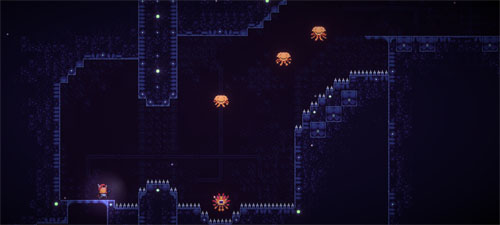A game by PÔLE 3D for PC, originally released in 2020.
Out of Fix is a bite-sized precision/puzzle platformer that takes place aboard a spaceship that has crashed in the desert of an unknown world. You take on the role of a maintenance robot who becomes active many years after the impact, venturing out to find pieces to repair the ship. However, the hull has been breached, and some of the local fauna have made the ship their home. Fortunately, the robot can use these creatures to help him bypass the many spike traps… way more spike traps than you usually find on a galactic star cruiser (just sayin’).The robot has a 2x variable jump and is able to dash in eight directions, allowing him to cross gaps and reach high platforms. He can also perform a short melee attack, and at any point, he can warp back to the opening of the current room, acting as a quick reset should the player mess up.
Early on, the player learns that dashing through an enemy allows him to extend the range of the dash, and dashing through multiple enemies in succession extends it even farther. The dash works similarly that of Celeste, from which this game drew inspiration. The bot can perform a single dash in midair, which causes the his hood to turn blue, similar to Celeste’s hair color changing when she performs air dashes.
When the bot touches the ground, his hood turns red again, indicating that he can perform another dash. But if the bot manages to dash through an enemy, his hood turns red and he is able to perform another air dash without the need to touch the ground. This mechanic is used extensively as the bot encounters successively more difficult configurations of enemies and spike traps.
Some enemies have spikes protruding from them, indicating that the player should slash them rather than dash through them, and attacking an enemy while in the air also earns the player another dash. Attacking an enemy from above allows the player to bounce upward a bit, which is also used to extend his reach. Often, the player must bounce off of one enemy and then slash through one or two others in order to remain aloft.
Finally, there is a switch enemy, and slashing it causes spiked enemies to retract their spikes and vice versa. These switch enemies can also be attacked from above in order to give the player another bounce. With this tactic learned, the player must then alternate between dashing through enemies, bouncing off switches, and then dashing through enemies whose spikes have retracted, often without touching the ground in between.
When the game begins, the robot is in the bowels of the ship, but eventually he makes his way to an area where there are no enemies. Here, wind can be heard howling through cracks in the ship, and eventually the robot reaches an area where he can see off into the distance of the planet.
This area also introduces a new mechanic in the form of blocks that alternate between solid and transparent every time the player performs a dash. At first, the player merely uses these blocks as a means of environmental traversal, but eventually the player must contend with these blocks while also dealing with enemies. These sequences often require the player to perform multiple midair attacks while also getting the timing right to create a safe platform to land on, or dashing at the right time to make a wall disappear.
Getting killed generally returns the player to the start of the room, but the player has infinite lives, and there is no penalty for failure other than a short amount of repeated gameplay. Killed enemies respawn after a few seconds, so if the player manages to stay alive – which is unlikely given the overwhelming number of spikes – he can give it another go. The game can be completed in around 20 minutes, provided the player has the skills to reach the end.
The game features a limited tile set, essentially consisting of a single indoor environment and a single outdoor environment, with some overlap between the two, combined with a bit of ambient music and atmospheric sound effects. The game permutes on several puzzle platforming and environmental traversal elements over its short length, but it does not introduce any new abilities to the player. It certainly has the foundations of a more fleshed-out experience.
2D CRED
Out of Fix was developed as part of coursework at the PÔLE 3D college, founded in 2003 and based in Roubaix, France, which teaches 2D and 3D video game animations. The game was developed by students from this school. Pierre Morreel is credited as art director, game designer, and level designer. Guillaume Leclercq is credited as animator, tech artist, and game designer. Loïc Mouray is credited as programmer. Martin Delemotte is credited as level designer. And Clément Rigolli is credited with game design and sound design. Music for the game was composed by François Surma, who is not a student at the school. The game's development was completed over the course of three months.






















0 comments:
Post a Comment